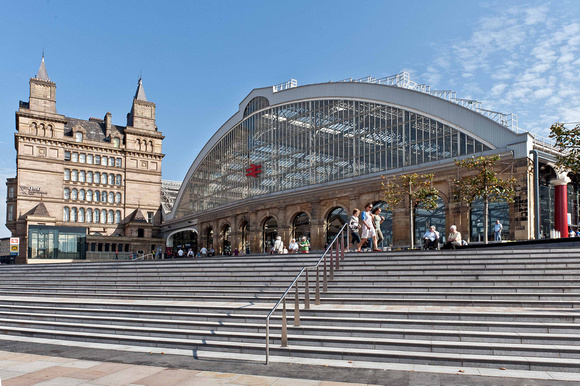Lime Street Station facade
Liverpool Lime Street railway station is a railway station serving the city centre of Liverpool, England. The station lies on a branch of the West Coast Main Line from London Euston, and on the Wirral Line of the Merseyrail network. The station is by far the largest railway station in Liverpool city centre and one of the 19 stations managed by Network Rail.
In the early days of the Liverpool and Manchester Railway (Lamp;MR), the Liverpool terminus was located at Crown Street, in Edge Hill, officially opened in 1830. Construction of a purpose-built station began in October 1833, the land being purchased from Liverpool Corporation for £9000. A tunnel was constructed between Edge Hill and the new station (starting in 1832, prior to station construction), and the station was opened to the public in August 1836, although construction was not completed until the following year. Because of the steep incline between Lime Street and Edge Hill, trains were stopped at Edge Hill, their locomotives removed, and the passenger carriages taken down by gravity, descent controlled by brakemen. The return journey was achieved by using a stationary engine to haul the carriages up with rope. Within six years, the rapid growth of the railways meant that the original station needed to be extended, and a plan was made to erect an iron roof similar to that found at Euston station in London, ridge roofs supported by iron columns; however, Richard Turner and William Fairburn submitted a design for a single curved roof, which won the approval of the station committee. The work cost £15,000, and was completed in 1849. A second roof was added in the 1880s. In 1845 the Lamp;MR was absorbed by its principal business partner, the Grand Junction Railway (GJR); the following year the GJR formed part of the London and North Western Railway. The station was one of the first to send mail by train. The North Western Hotel designed by Alfred Waterhouse, was built in front of the station - this still stands, having been converted to accommodation for students of Liverpool John Moores University. At 'the grouping' in 1923, the station passed to the ownership of the London, Midland and Scottish (LMS) railway, and, in 1948, the London Midland Region of British Railways. Lime Street was part of the first stage of electrification of the West Coast Main Line in 1959. In 1966, the station saw the launch of the first InterCity service. Lime Street was voted the equal worst of the 20 busiest UK railway stations in a 2007 poll but was voted "Station of the Year 2010" at the National Rail Awards thanks in part to a recent reburbishment.


